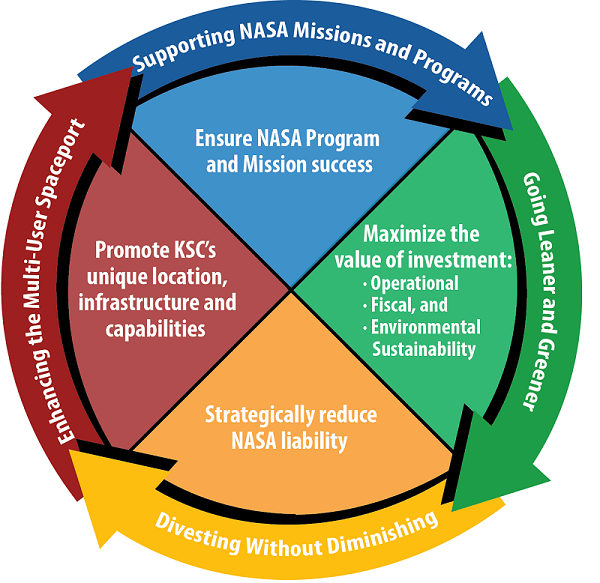
Core Strategies

NASA Strategic Goals:
KSC’s vision, mission, goals and objectives expressed in The Director’s Planning Guidance support NASA’s strategic goals for 2011 through 2021 and beyond including:
- Strategic Goal 1: Extend and sustain human activities across the solar system.
- Strategic Goal 2: Expand scientific understanding of the Earth and the universe in which we live.
- Strategic Goal 3: Create the innovative new space technologies for our exploration, science, and economic future.
- Strategic Goal 4: Advance aeronautics research for societal benefit.
- Strategic Goal 5: Enable program and institutional capabilities to conduct NASA’s aeronautics and space activities.
- Strategic Goal 6: Share NASA with the public, educators, and students to provide opportunities to participate in our Mission, foster innovation, and contribute to a strong national economy.
KSC Strategic Goals and Objectives:
The KSC of tomorrow will not be the KSC of today. In these austere budget times, KSC must continue to become more efficient and accommodating to share capabilities and enable the emerging commercial space industry. KSC will transform from a government and program-focused, single user launch complex to a more capability-centric and cost-effective multi-user spaceport, enabling both government and commercial space activities.
KSC is at a crossroads, which is both exciting and challenging. The test is being able to adjust to new demands and also respond with rigor and purpose. The path forward that KSC chooses will be watched by other NASA Centers, other agencies, the commercial space market and the world. KSC will build upon the accomplishments of its past and lead America’s space program into the 21st century supported by the following strategic goals.
- Goal 1: Ensure mission success by enabling Government and commercial access to space.”KSC’s future depends on its ability to move from government processing and acquisition to an environment supporting diverse government and commercial entities with full life-cycle support. The prospect of a joint Government-commercial space program is entirely practicable and within reach.
- Goal 2: KSC will move from program-specific infrastructure to a launch and payload processing complex that will support multiple users with varying requirements. KSC will enable commercial partners to use its launch resources by providing high-quality, economical processing and launch capabilities. Through partnerships with industry, academia, and other Government entities, KSC will promote the use of their available facilities and highly skilled workforce, attracting new businesses to the spaceport. KSC’s future hinges on the ability of its workforce to bring expertise, dedication, innovation, vision, and frugality to their work.
- Supporting Objective 2.1: Convert the KSC launch and payload processing complex into a multi-user capability.
- Supporting Objective 2.2: Establish plans, processes, and agreements to support multi-user activity.
- Goal 3: NASA relies on KSC to make advancements and innovations in next-generation technologies to make NASA, other Government, and commercial space activities more capable and affordable. Technology areas include resource utilization and surface systems, space launch and suborbital technologies, life sciences and habitation systems, ISS multi-discipline research, environmental remediation and ecosystem sciences, and advanced ground launch and processing systems.
- Supporting Objective 3.1: Advance KSC’s research and technology (R&T) into relevant uses for KSC, NASA, and the Nation.
- Supporting Objective 3.2: Conduct R&T development to enhance NASA capabilities to explore.
- Supporting Objective 3.3: Perform R&T to enhance surface and launch systems for any destination.
- Goal 4: KSC will transform its organization, workforce, facilities, and services to a multi-user model while reducing costs. KSC’s civil service workforce will be realigned with NASA goals and KSC’s institutional services will undergo changes. KSC must provide technical capabilities at an equitable price and implement a ground and launch operations contract to support multiple customers. KSC will make infrastructure improvements that reduce operating costs and will position KSC to be a stronger, more resilient organization.
- Supporting Objective 4.1: Align civil service and contractor workforce with NASA and KSC goals and plan.
- Supporting Objective 4.2: Continue the transformation of institutional facilities and infrastructure to support future needs.
- Supporting Objective 4.3: Continue the transformation of technical capabilities/services required to support future NASA and other multi-use programs.
- Supporting Objective 4.4: Establish a model sustainability program.
- Goal 5: The success of KSC is directly tied to its most valuable asset: its workforce. For KSC to continue to lead the world in space exploration, it must show children the possibilities that await them in the science, technology, engineering, and math (STEM) fields. KSC will establish partnerships to leverage educational activities with aerospace companies, minority institutions, county school boards, and universities.
- Supporting Objective 5.1: Assure effective community involvement, partnerships, science, technology, engineering, and math (STEM) awareness.
- Supporting Objective 5.2: Increase STEM student opportunities at KSC.